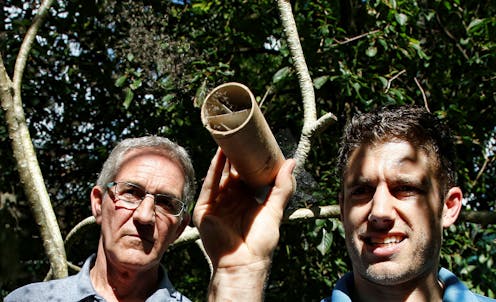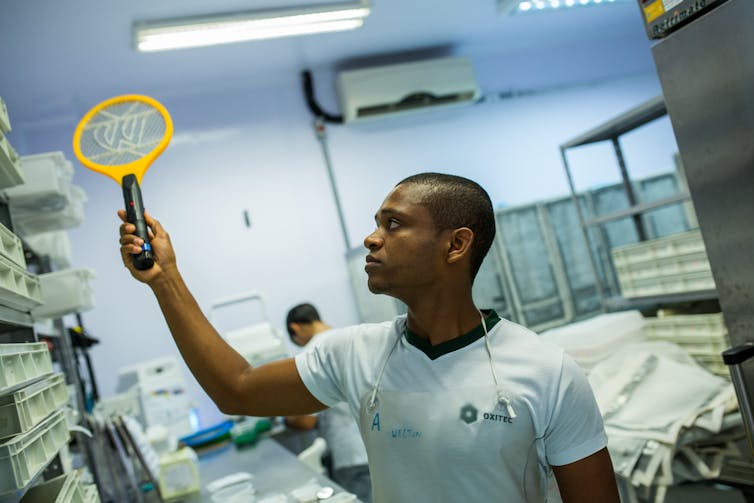Genetically modified mosquitoes could be released in Florida and Texas beginning this summer – silve
Release of GM mosquitoes in Florida is imminent. But a multidisciplinary team of scientists believe that more studies are needed first. They encourage a publicly accessible registry for GM organisms.

This summer, for the first time, genetically modified mosquitoes could be released in the U.S.
On May 1, 2020, the company Oxitec received an experimental use permit from the U.S. Environmental Protection Agency to release millions of GM mosquitoes (labeled by Oxitec as OX5034) every week over the next two years in Florida and Texas. Females of this mosquito species, Aedes aegypti, transmit dengue, chikungunya, yellow fever and Zika viruses. When these lab-bred GM males are released and mate with wild females, their female offspring die. Continual, large-scale releases of these OX5034 GM males should eventually cause the temporary collapse of a wild population.
However, as vector biologists, geneticists, policy experts and bioethicists, we are concerned that current government oversight and scientific evaluation of GM mosquitoes do not ensure their responsible deployment.
Genetic engineering for disease control
Coral reefs that can withstand rising sea temperatures, American chestnut trees that can survive blight and mosquitoes that can’t spread disease are examples of how genetic engineering may transform the natural world.
Genetic engineering offers an unprecedented opportunity for humans to reshape the fundamental structure of the biological world. Yet, as new advances in genetic decoding and gene editing emerge with speed and enthusiasm, the ecological systems they could alter remain enormously complex and understudied.
Recently, no group of organisms has received more attention for genetic modification than mosquitoes – to yield inviable offspring or make them unsuitable for disease transmission. These strategies hold considerable potential benefits for the hundreds of millions of people impacted by mosquito-borne diseases each year.
Although the EPA approved the permit for Oxitec, state approval is still required. A previously planned release in the Florida Keys of an earlier version of Oxitec’s GM mosquito (OX513) was withdrawn in 2016 after a referendum indicated significant opposition from local residents. Oxitec has field-trialed their GM mosquitoes in Brazil, the Cayman Islands, Malaysia and Panama.
The public forum on Oxitec’s recent permit application garnered 31,174 comments opposing release and 56 in support. The EPA considered these during their review process.

Time to reassess risk assessment?
However, it is difficult to assess how EPA regulators weighed and considered public comments and how much of the evidence used in final risk determinations was provided solely by the technology developers.
The closed nature of this risk assessment process is concerning to us.
There is a potential bias and conflict of interest when experimental trials and assessments of ecological risk lack political accountability and are performed by, or in close collaboration with, the technology developers.
This scenario becomes more troubling with a for-profit technology company when cost- and risk-benefit analyses comparing GM mosquitoes to other approaches aren’t being conducted.
Another concern is that risk assessments tend to focus on only a narrow set of biological parameters – such as the potential for the GM mosquito to transmit disease or the potential of the mosquitoes’ new proteins to trigger an allergic response in people – and neglect other important biological, ethical and social considerations.
To address these shortcomings, the Institute for Sustainability, Energy and Environment at University of Illinois Urbana-Champaign convened a “Critical Conversation” on GM mosquitoes. The discussion involved 35 participants from academic, government and nonprofit organizations from around the world with expertise in mosquito biology, community engagement and risk assessment.
A primary takeaway from this conversation was an urgent need to make regulatory procedures more transparent, comprehensive and protected from biases and conflicts of interest. In short, we believe it is time to reassess risk assessment for GM mosquitoes. Here are some of the key elements we recommend.

Steps to make risk assessment more open and comprehensive
First, an official, government-funded registry for GM organisms specifically designed to reproduce in the wild and intended for release in the U.S. would make risk assessments more transparent and accountable. Similar to the U.S. database that lists all human clinical trials, this field trial registry would require all technology developers to disclose intentions to release, information on their GM strategy, scale and location of release and intentions for data collection.
This registry could be presented in a way that protects intellectual property rights, just as therapies entering clinical trials are patent-protected in their registry. The GM organism registry would be updated in real time and made fully available to the public.
Second, a broader set of risks needs to be assessed and an evidence base needs to be generated by third-party researchers. Because each GM mosquito is released into a unique environment, risk assessments and experiments prior to and during trial releases should address local effects on the ecosystem and food webs. They should also probe the disease transmission potential of the mosquito’s wild counterparts and ecological competitors, examine evolutionary pressures on disease agents in the mosquito community and track the gene flow between GM and wild mosquitoes.
To identify and assess risks, a commitment of funding is necessary. The U.S. EPA’s recent announcement that it would improve general risk assessment analysis for biotechnology products is a good start. But regulatory and funding support for an external advisory committee to review assessments for GM organisms released in the wild is also needed; diverse expertise and local community representation would secure a more fair and comprehensive assessment.
Furthermore, independent researchers and advisers could help guide what data are collected during trials to reduce uncertainty and inform future large-scale releases and risk assessments.
The objective to reduce or even eliminate mosquito-borne disease is laudable. GM mosquitoes could prove to be an important tool in alleviating global health burdens. However, to ensure their success, we believe that regulatory frameworks for open, comprehensive and participatory decision-making are urgently needed.
[Deep knowledge, daily. Sign up for The Conversation’s newsletter.]
Brian Allan receives funding from the Institute for Sustainability, Energy and Environment.
Jennifer Kuzma receives funding from the U.S. Department of Agriculture, Walton Family Foundation and National Science Foundation..
Natalie Kofler receives funding from the University of Illinois Institute for Sustainability, Energy and the Environment. She is an advisor for the Scientific Citizenship Initiative at Harvard Medical School and founder of Editing Nature.
Chris Stone and Holly Tuten do not work for, consult, own shares in or receive funding from any company or organisation that would benefit from this article, and have disclosed no relevant affiliations beyond their academic appointment.
Read These Next
How the ‘slayer rule’ might play a role in determining who will inherit wealth from Rob Reiner and h
These rules have a long history in the United States. They played a role in the notorious murders by…
The celibate, dancing Shakers were once seen as a threat to society – 250 years later, they’re part
‘The Testament of Ann Lee,’ Mona Fastvold’s 2025 film, depicts part of the long history of Shaker…
As DOJ begins to release Epstein files, his many victims deserve more attention than the powerful me
Powerful men connected to Jeffrey Epstein are named, dissected and speculated about. The survivors,…






